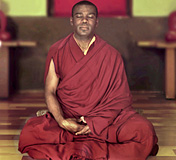Meditation Guide
Posture
Sit on your cushion or chair so that your body is both comfortable and stable. Your legs may either be crossed in a half lotus or full lotus position, or with your feet on the floor if you are in a chair. They should be placed so that, once you put them there, they will remain in the same place without effort to keep them there.
Your hands should be either resting on your lap, with one palm resting on top of the other palm, or with the hands resting comfortably on their respective knees. Arms should be not too close to the body (so as to cause heating/sweating) nor too far away (so as to require any effort to maintain the posture, or so that it feels unnatural).
Your back should be in a naturally straight position and, once placed there, should be able to remain without effort or discomfort. Your shoulders should be relaxed. Just let them go. Your head and neck should be stable and centered without having to make any conscious effort to keep them that way.
Your eyes may be open, half-opened or closed depending on what works best for you. Your mouth should be in its natural position, your jaw neither too slack nor too tightly closed. Your teeth and tongue should be in their natural position, with the tip of the tongue lightly touching the top of the upper row of teeth. Your facial muscles should be relaxed.
Feel your body relax into this posture. Check each area of the body and make any adjustments needed. It's important to achieve the most comfortable and stable body position you can to have success in your meditation, so be sure to take the time to make any corrections required, even if they seem inconsequential at the time.

